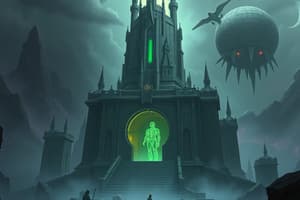Podcast
Questions and Answers
What is a Safe-class SCP?
What is a Safe-class SCP?
- Anomaly that requires significant resources to contain.
- A type that is easily and safely contained. (correct)
- Contains mental anomalies.
- An anomaly only dangerous if activated.
What does the term Euclid-class refer to?
What does the term Euclid-class refer to?
- Anomaly that is very dangerous.
- A well-contained SCP.
- An instrument for containment.
- An anomaly that requires significant resources but its containment isn't always reliable. (correct)
Keter-class SCPs are known for being:
Keter-class SCPs are known for being:
- Autonomous and sentient.
- Very difficult and costly to contain. (correct)
- Completely harmless.
- Easily contained.
What does Thaumiel-class SCP imply?
What does Thaumiel-class SCP imply?
What is the significance of the term Apollyon?
What is the significance of the term Apollyon?
What does it mean when an SCP is classified as Neutralized?
What does it mean when an SCP is classified as Neutralized?
Which class of personnel is not allowed direct access to anomalies?
Which class of personnel is not allowed direct access to anomalies?
What is a Level 0 security clearance?
What is a Level 0 security clearance?
Who are Class D personnel?
Who are Class D personnel?
What is the primary role of the O5 Council?
What is the primary role of the O5 Council?
Flashcards are hidden until you start studying
Study Notes
SCP Classifications
- Safe: Anomalies that are easily contained with minimal resources; handling may still pose a threat despite the classification.
- Euclid: Requires more resources for containment and is less predictable; often applies to autonomous or sentient SCPs due to their unpredictable nature.
- Keter: Extremely difficult to contain; high complexity in procedures; not necessarily dangerous but costly or challenging to manage.
- Thaumiel: Used by the Foundation to contain or counteract other SCPs; their functions are highly classified and known only to a select few.
- Apollyon: An SCP akin to "The Angel of Death," which is nearly impossible to contain and poses a significant threat to human life.
- Neutralized: Anomalies that have lost their properties due to destruction or disabling.
- Explained: Anomalies fully understood by mainstream science, no longer considered anomalous.
- Maksur: Broken or damaged SCPs, exemplified by "The Broken God."
- 53: An SCP with no known information, deemed not dangerous; connected to Scantron’s Proposal SCP-001.
Security Clearance Levels
- Level 0 (For Official Use Only): Granted to non-essential personnel without access to sensitive information; typically includes clerical and janitorial staff.
- Level 1 (Confidential): For personnel near containment but without access to anomalies; usually clerical, logistics, or janitorial staff handling sensitive information.
- Level 2 (Restricted): Granted to security and research staff needing access to anomaly data; includes most researchers and containment specialists.
- Level 3 (Secret): For senior staff that require detailed information regarding anomalies; includes senior researchers and Mobile Task Force operatives.
- Level 4 (Top Secret): Access for high-ranking administrative personnel needing site-wide intelligence; typically held by Site and Security Directors.
- Level 5 (Thaumiel): Highest clearance for top administrative officials; grants unlimited access to strategic and sensitive data.
Personnel Classes
- Class A: Essential personnel prohibited from direct anomaly access; must be evacuated to secure areas during emergencies.
- Class B: Personnel involved in local operations, granted access to cleared anomalies; must evacuate during breaches.
- Class C: Personnel with access to most non-hostile anomalies; potential for mandatory quarantine if exposed to certain properties.
- Class D: Expendable personnel for handling hazardous anomalies; typically sourced from prisoners and subjected to strict evaluations and termination protocols.
- Class E: Provisional classification for field agents exposed to dangers during containment efforts; requires quarantine and medical clearance before returning to duty.
O5 Council
- Comprises the highest-ranking directors with complete access to containment information; directs Foundation operations worldwide.
- Identities of members are classified; they are referred to only by numeric designations (O5-1 through O5-13).
- Must avoid direct contact with anomalous entities due to the sensitivity of their positions.
Studying That Suits You
Use AI to generate personalized quizzes and flashcards to suit your learning preferences.




